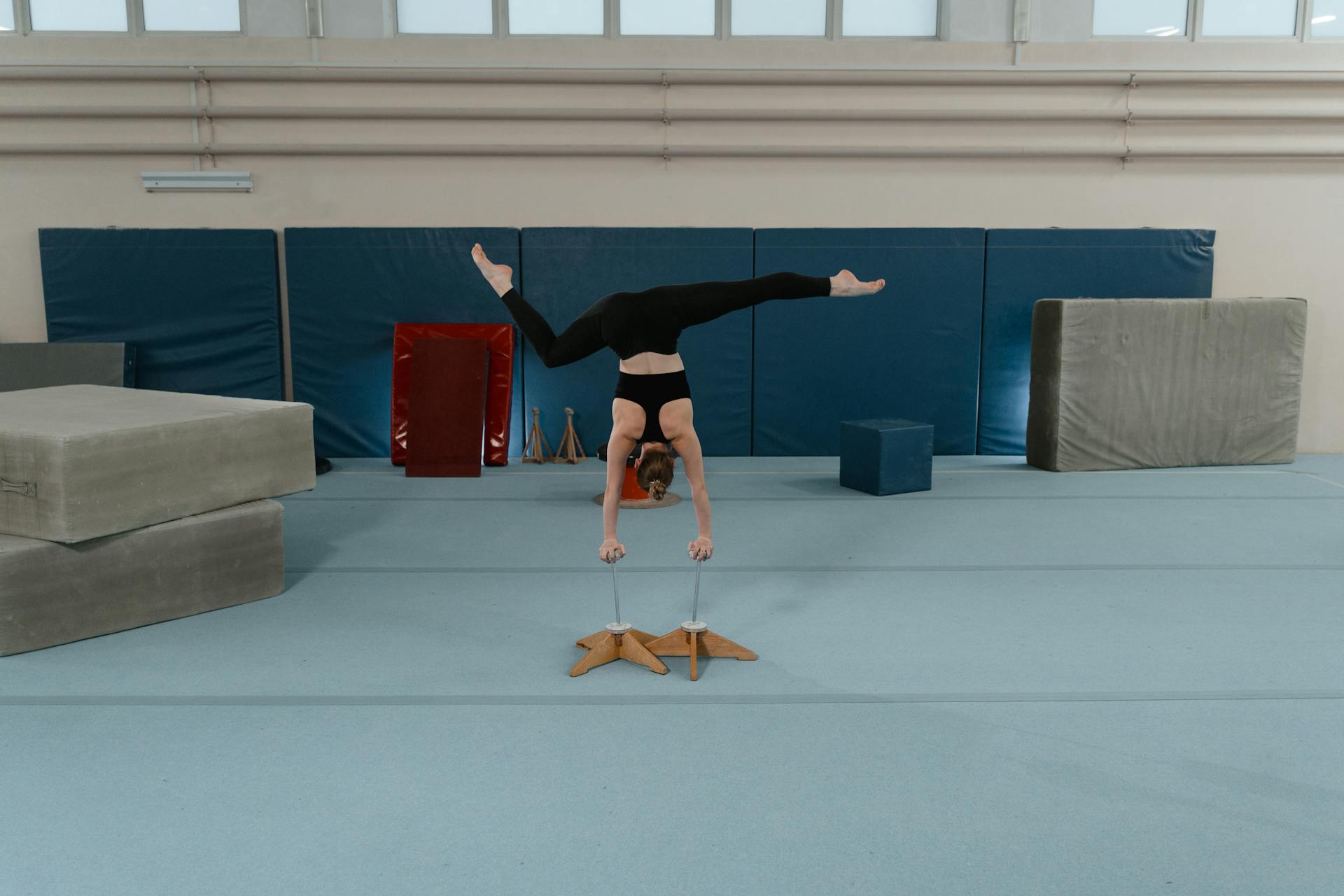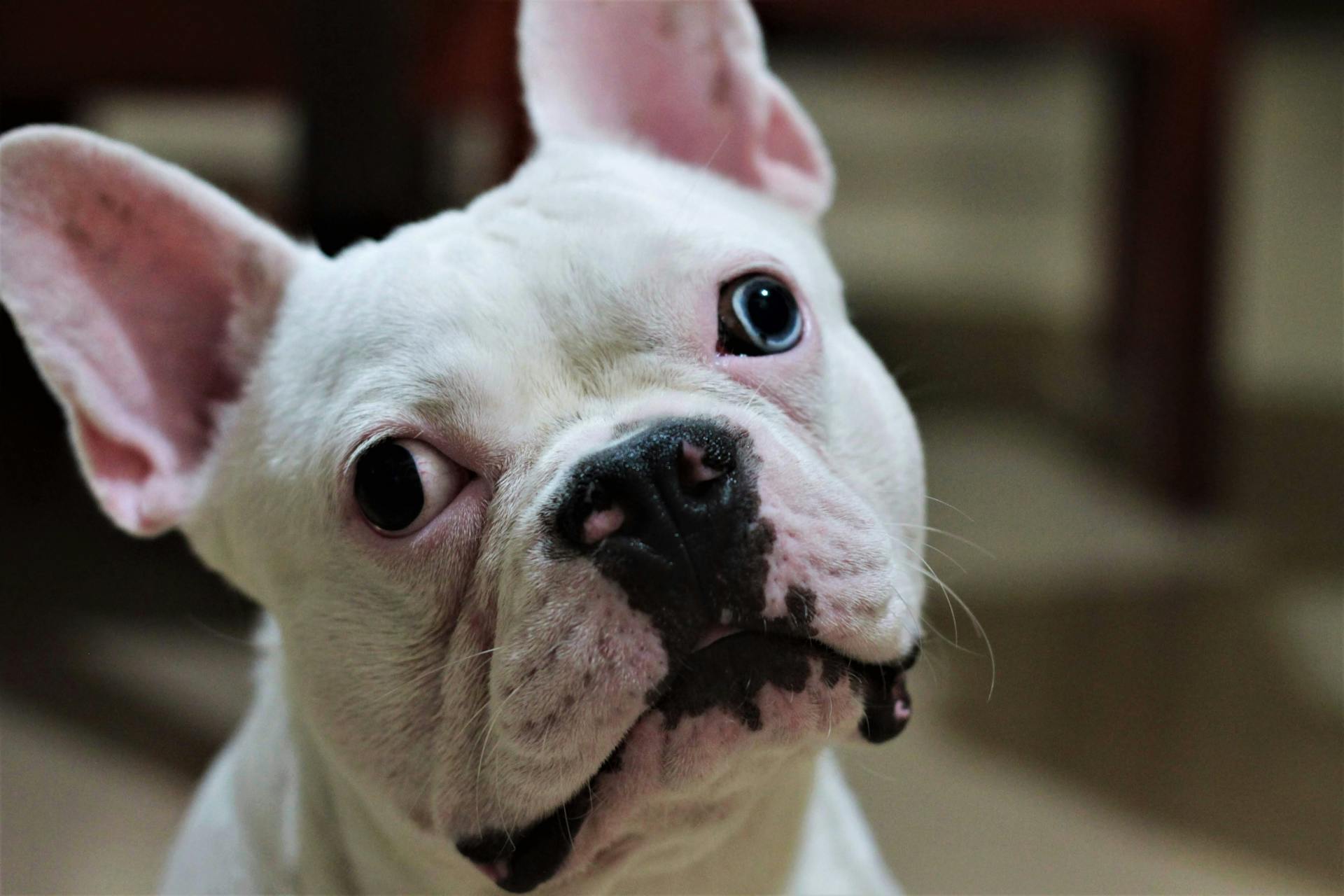
French Bulldogs are adorable companions, but their flat faces can make breathing a challenge.
Their brachycephalic skull structure, characterized by a short, pushed-in nose and a long soft palate, can cause airway obstruction, leading to breathing difficulties.
This unique anatomy can also lead to overheating, as the breed's short nasal passages and narrow airways make it hard for them to dissipate heat efficiently.
French Bulldogs are prone to respiratory issues, such as stenotic nares, elongated soft palate, and tracheal collapse, which can exacerbate breathing problems.
For your interest: English Bulldog Breathing Problems
Understanding French Bulldogs' Breathing Issues
French Bulldogs are prone to breathing issues due to their unique flat-face appearance. This can cause respiratory problems, ranging from mild to severe.
Allergies, infections, and obesity can also contribute to breathing difficulties in French Bulldogs. However, the most common issues are related to their brachycephalic breed characteristics.
The soft palate plays a crucial role in breathing and swallowing, but in French Bulldogs, it can be too long and partially block the airway, causing breathing problems and snoring.
Genetic predisposition, brachycephalic breed characteristics, and being overweight can all contribute to an elongated soft palate in French Bulldogs.
Some common breathing issues in French Bulldogs include stenotic nares, elongated soft palate, brachycephalic syndrome, tracheal stenosis, laryngeal collapse, and hypoplastic trachea.
Here are some of the common breathing problems that a French Bulldog may face:
- Stenotic Nares: This is where the nostrils are too narrow, causing difficulty in air intake.
- Elongated Soft Palate: The soft palate is overly long for the mouth, blocking the trachea during inhalation.
- Brachycephalic Syndrome: A collective term for the effect of the flat-faced skull shape on the overall respiratory function, including issues such as stenotic nares and elongated soft palate.
- Tracheal Stenosis: A narrowed trachea that can severely restrict airflow to the lungs.
- Laryngeal Collapse: Weakening of laryngeal cartilage due to increased respiratory effort and chronic airway obstruction.
- Hypoplastic Trachea: A condition where the trachea is underdeveloped, it’s smaller in diameter than usual, which can lead to breathing difficulties.
Causes and Anatomy
French Bulldogs' unique anatomy can make breathing a challenge. Their short skulls lead to compressed upper respiratory structures, causing narrowed nostrils and elongated soft palates.
This compression obstructs airflow, making it harder for them to breathe, especially during exertion or stress. Smaller nostrils also contribute to this issue, as they limit the amount of air that can enter the lungs.
Their elongated soft palate can block the entrance to the trachea, creating breathing difficulties. The trachea itself may be abnormally narrow, restricting airflow and making it difficult for French Bulldogs to cool down through panting.
Here are some key factors contributing to French Bulldogs' breathing issues:
- Brachycephalic Airway Syndrome
- Narrowed Nostrils
- Elongated Soft Palate
- Tracheal Stenosis
Anatomy of a Normal vs. Abnormal Patterns
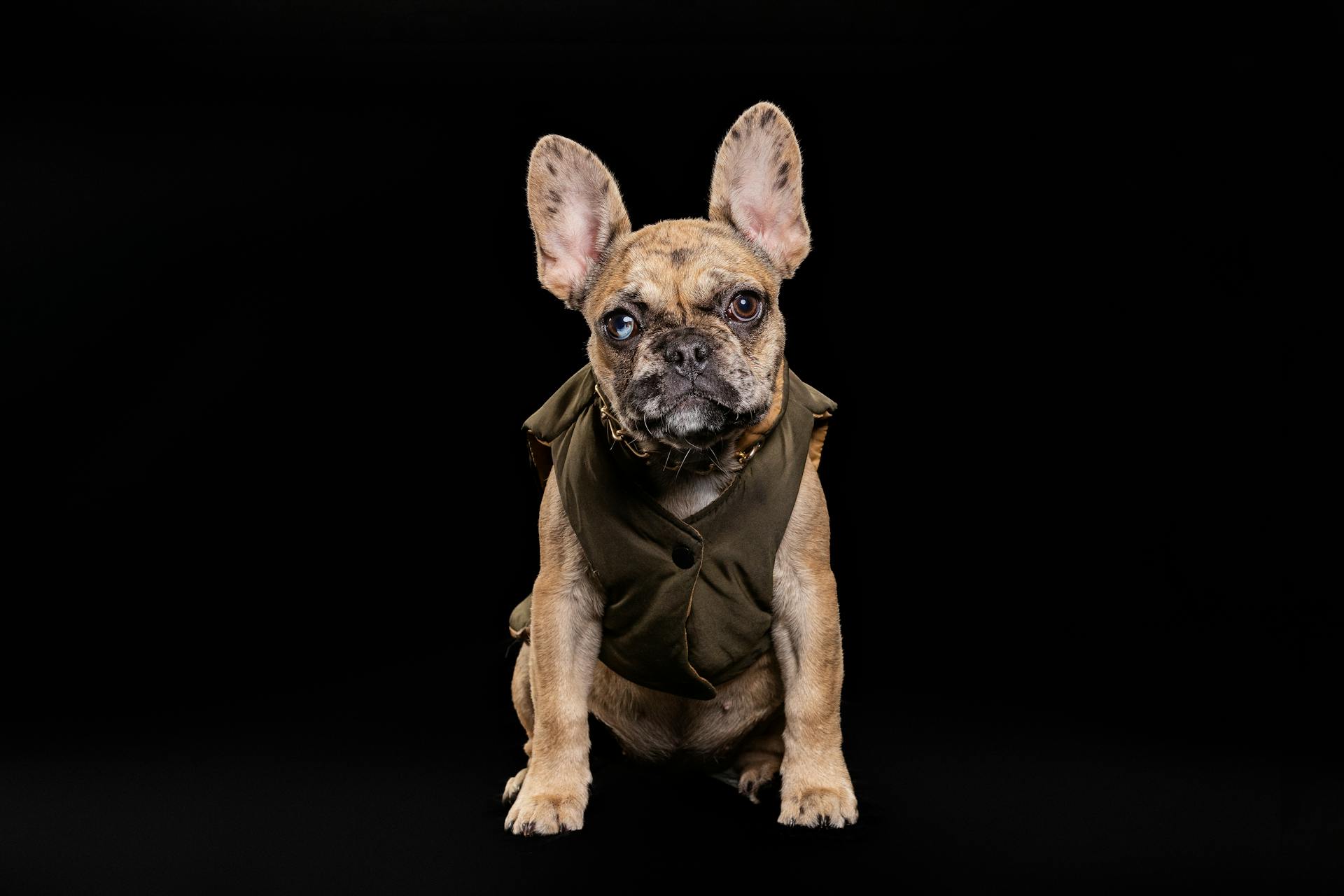
A French Bulldog's unique anatomy can make their breathing patterns look abnormal, even when they're perfectly healthy. This can be concerning for new owners who aren't familiar with their breed's characteristics.
Their short snout and narrow nostrils mean they can intake less air per breath, which can lead to rapid breathing and panting. This is especially true when they're excited or exercising.
Normally, a French Bulldog should breathe with deep abdominal movement, taking even and regular breaths. However, their breathing sound can be pronounced loud, and some may snore.
If your Frenchie is breathing rapidly, accompanied by coughing or wheezing, it's a cause for concern. Shallow breaths, snoring, gagging, and open-mouth breathing are all signs of abnormal breathing in this breed.
Here's a quick rundown of the differences between normal and abnormal breathing patterns in French Bulldogs:
By understanding what's normal for your Frenchie, you can catch any potential issues early on and ensure they get the care they need to stay happy and healthy.
Brachycephalic Airway Syndrome
Brachycephalic Airway Syndrome is a set of medical conditions that affect punch-faced dog breeds, including French Bulldogs and Bulldogs. It's caused by their unique appearance, which compromises their airway and makes breathing difficult.
The word brachycephalic is Greek for "flat-faced", and it's a direct result of selective breeding for their distinctive look. This has led to a range of respiratory problems, including snoring, wheezing, and panting.
Brachycephalic Airway Syndrome, or BAS, is characterized by a range of symptoms, including reverse sneezing, coughing, exercise intolerance, gagging or vomiting, and excessive salivation. In severe cases, it can even lead to heart disease.
The main components of BAS include elongated soft palate, stenotic nares, hypoplastic trachea, large tongue, laryngeal collapse, everted laryngeal saccules, thicker nasal turbinates, and swollen tonsils. These abnormalities can make it difficult for dogs to breathe, especially during exertion or stress.
Here are some common symptoms of Brachycephalic Airway Syndrome:
- Reverse sneezing
- Coughing
- Exercise intolerance
- Gagging or vomiting
- Excessive Salivation
According to a study, 93% of French Bulldogs with BAS also had gastrointestinal signs.
Stenotic Nares
Stenotic Nares is a common issue in French Bulldogs, characterized by pinched nostrils that make it difficult for them to breathe properly. This genetic defect is present in brachycephalic breeds, including French Bulldogs.
Stenosis can range from mild to severe, and most dogs can live with it without any health concerns. However, if the condition is severe and the dog is breathing abnormally, medical treatment is required.
Dogs with stenotic nares can exhibit several signs, including restlessness, open mouth breathing, and even paralysis. These symptoms can be distressing for both the dog and the owner.
If you suspect that your French Bulldog has stenotic nares, it's essential to consult with a veterinarian for proper diagnosis and treatment.
Broaden your view: Are French Bulldogs Good Apartment Dogs
Common Issues and Symptoms
French Bulldogs are prone to breathing problems due to their flat-face appearance, which can cause a range of issues.
Stenotic Nares is a common problem, where the nostrils are too narrow, making it hard for air to enter the lungs.
An elongated Soft Palate can also cause breathing difficulties, as it blocks the trachea during inhalation.
Brachycephalic Syndrome is a collective term for the respiratory issues caused by the flat-faced skull shape, including stenotic nares and elongated soft palate.
Tracheal Stenosis can severely restrict airflow to the lungs, making breathing even more challenging.
Laryngeal Collapse occurs when the laryngeal cartilage weakens due to increased respiratory effort and chronic airway obstruction.
Hypoplastic Trachea is a condition where the trachea is underdeveloped, leading to breathing difficulties.
Common symptoms of these issues include wheezing, panting, and rapid breathing.
Medical Treatments and Solutions
Medical treatments for French Bulldogs can be a bit complex, but the good news is that many breathing problems can be controlled with medication. Some medications, like cough suppressants and bronchodilators, can provide symptomatic relief for your dog's condition.
Your veterinarian may prescribe antibiotics if your dog develops a secondary infection like aspiration pneumonia. They might also prescribe other medications, such as guaifenesin cough tablets, Cerenia (maropitant) for anti-nausea and airway benefits, or opioid cough medications.
In some cases, your veterinarian will use steroids to decrease inflammation, or combination medications like Temaril-P, which use a steroid and cough medication together. Guaifenesin cough tablets Cerenia (maropitant), an anti-nausea medication that also benefits the airway Opioid cough medications are examples of medications that may be prescribed.
Solutions for Breathing
French Bulldogs can suffer from breathing difficulties, but there are solutions to provide relief. Home remedies and preventive measures can help.
Medications can treat secondary conditions contributing to breathing problems, such as allergies or infections. Your vet may prescribe anti-inflammatories or bronchodilators.
Bulldogs with respiratory issues may need medications like cough suppressants, bronchodilators, expectorants, and decongestants. These can provide symptomatic relief but may not be a permanent solution.
Your veterinarian will likely prescribe antibiotics if your dog develops a secondary infection like aspiration pneumonia. They may also prescribe medications like guaifenesin cough tablets, Cerenia (maropitant), or opioid cough medications.
To help your dog breathe more comfortably, consider using a harness to relieve pressure on the throat, or a cooling pad to lie on. You can also set up sprinklers or a pool for your dog to enjoy when it's hot outside.
Suggestion: How to Help a Bird with a Concussion?
Oxygen Therapy
Oxygen Therapy can be a lifesaver for dogs experiencing heat stroke or after intense exercise.
If your dog is breathing abnormally or losing consciousness, its gums may turn blue due to oxygen deficiency.
Oxygen therapy is indicated in this situation to provide the body with much-needed oxygen.
Providing oxygen to the body can significantly reduce the severity of a heat stroke.
Discover more: French Bulldogs and Heat
Home Remedies and Prevention
To reduce and prevent respiratory issues in your French Bulldog, try keeping them at a healthy weight through regular exercise and a balanced diet.
Monitoring their breathing and body temperature can also help you catch any potential problems early on.
Keep your home cool, especially in warm weather, as overheating can exacerbate breathing problems.
Home Remedies and Prevention Tips
To reduce respiratory issues in French Bulldogs, you can start by controlling temperature and humidity. This means keeping your home cool and dry, especially during hot summer months.
Avoid hot and humid environments at all costs, as this can exacerbate breathing problems. Open windows or turn on the AC to provide a cooler environment for your dog.
Using nasal drops can also help reduce respiratory issues. Sterile and medicated drops can be used regularly to keep the airway moist and reduce inflammation.
By following these simple tips, you can help prevent and manage breathing problems in your French Bulldog.
Weight Control
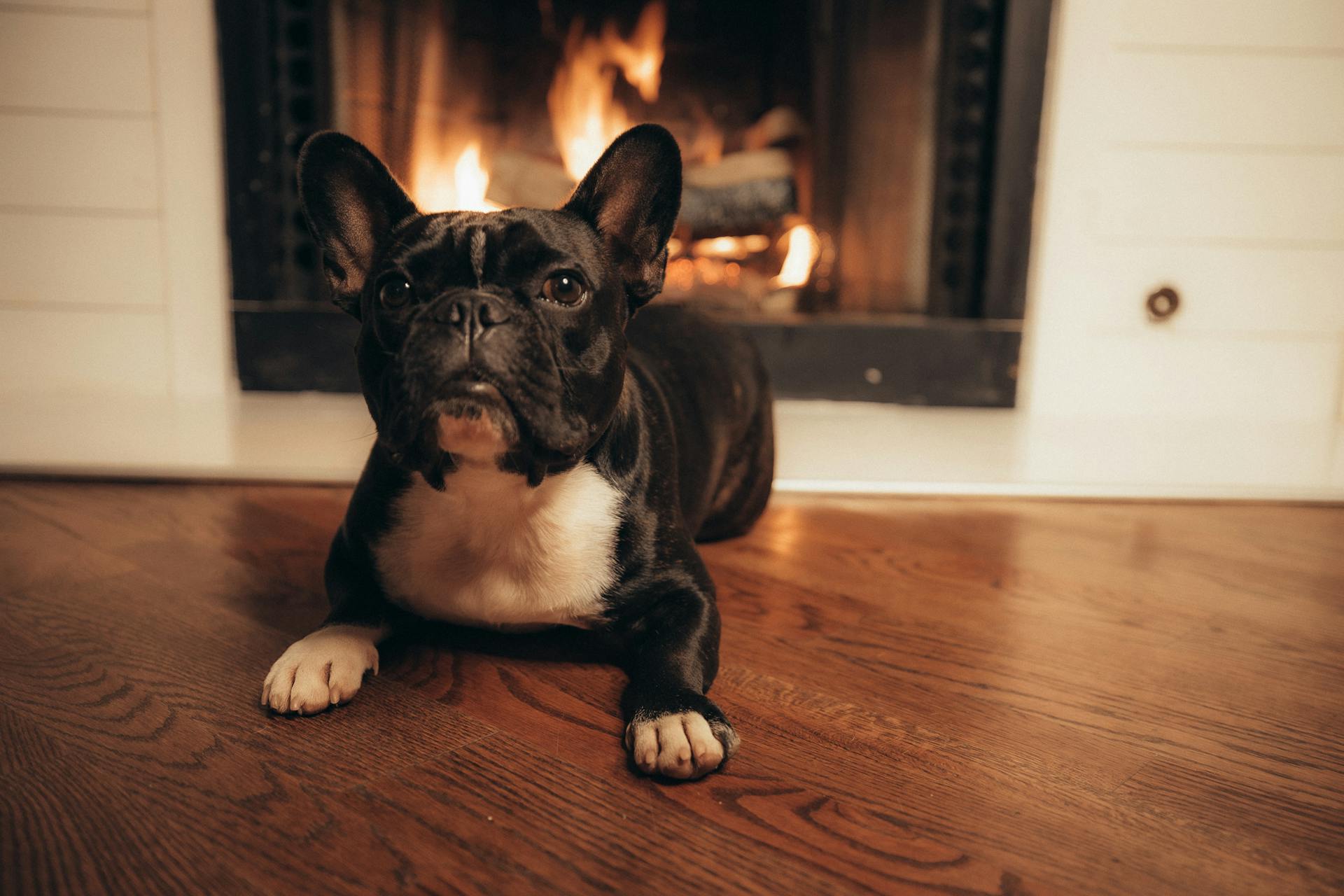
Maintaining a healthy weight is crucial for easing the burden on your dog's respiratory system. Obesity can worsen breathing difficulties, making it harder for your furry friend to breathe.
A balanced diet is essential for weight control. This means feeding your dog nutrient-rich food that meets their specific nutritional needs.
Consult with your vet to develop a diet plan that suits your dog's unique requirements. They'll help you create a plan that's tailored to your dog's age, breed, and health conditions.
Regular exercise is also vital for weight control. Aim for daily walks and playtime that get your dog moving and burning off those extra calories.
When to Seek Veterinary Help
As a French Bulldog owner, it's essential to know when to seek veterinary help for your furry friend.
If your dog starts to breathe rapidly, a wheezing sound begins, gums turn blue, chokes, or collapses, it's an emergency situation that may cause death.
You should rush to the vet if you notice any of these severe symptoms, and your vet will provide emergency medication and examination.
When to See a Vet
If your dog starts to breathe rapidly, it's an emergency situation that requires immediate veterinary attention.
Mild respiratory difficulty is a normal characteristic of some dog breeds, but sudden changes in breathing patterns can be a sign of a serious issue.
If your dog starts wheezing, it's a red flag that something's wrong and you should see a vet ASAP.
Gums turning blue is a clear indication that your dog is not getting enough oxygen and needs medical attention right away.
Collapses or choking can be life-threatening, so if you notice any of these symptoms, rush to your vet.
A vet will provide emergency medication and examination to help stabilize your dog's condition.
Regular Veterinary Check-ups
Regular veterinary check-ups are essential for monitoring breathing issues and adjusting treatment plans accordingly. This can be critical for long-term management and health.
Your vet can recommend preventive measures to help alleviate breathing difficulties. Regular check-ups can also help identify other health problems that may worsen breathing issues.
Early detection of changes in respiratory function can make a big difference in your pet's health. By catching these changes early, you can take action to prevent them from becoming more serious.
Regular veterinary check-ups can be a lifesaver for pets with breathing issues. They can help ensure your pet receives the best possible care and management for their condition.
Intriguing read: Why Adopting a Pet Is Better?
Surgical Options
Surgical options are available to help French Bulldogs breathe better. Surgery can improve airflow by widening narrowed nostrils or reducing an elongated soft palate.
In severe cases, surgery is usually recommended when dogs show signs of severe respiratory distress. A veterinarian will thoroughly examine your dog to determine if surgery is necessary.
The procedure, called staphyloplasty, is performed under general anesthesia and requires careful monitoring of the patient. The steps of soft palate surgery include preparation of the patient, general anesthetic, removal of excess soft palate tissue, stitching the wound, and waking up from anesthesia and observation.
A veterinarian will evaluate the potential benefits versus risks of surgery for your dog. This includes an examination of the mouth and respiratory tract and possibly X-rays or other imaging tests.
Surgical Correction
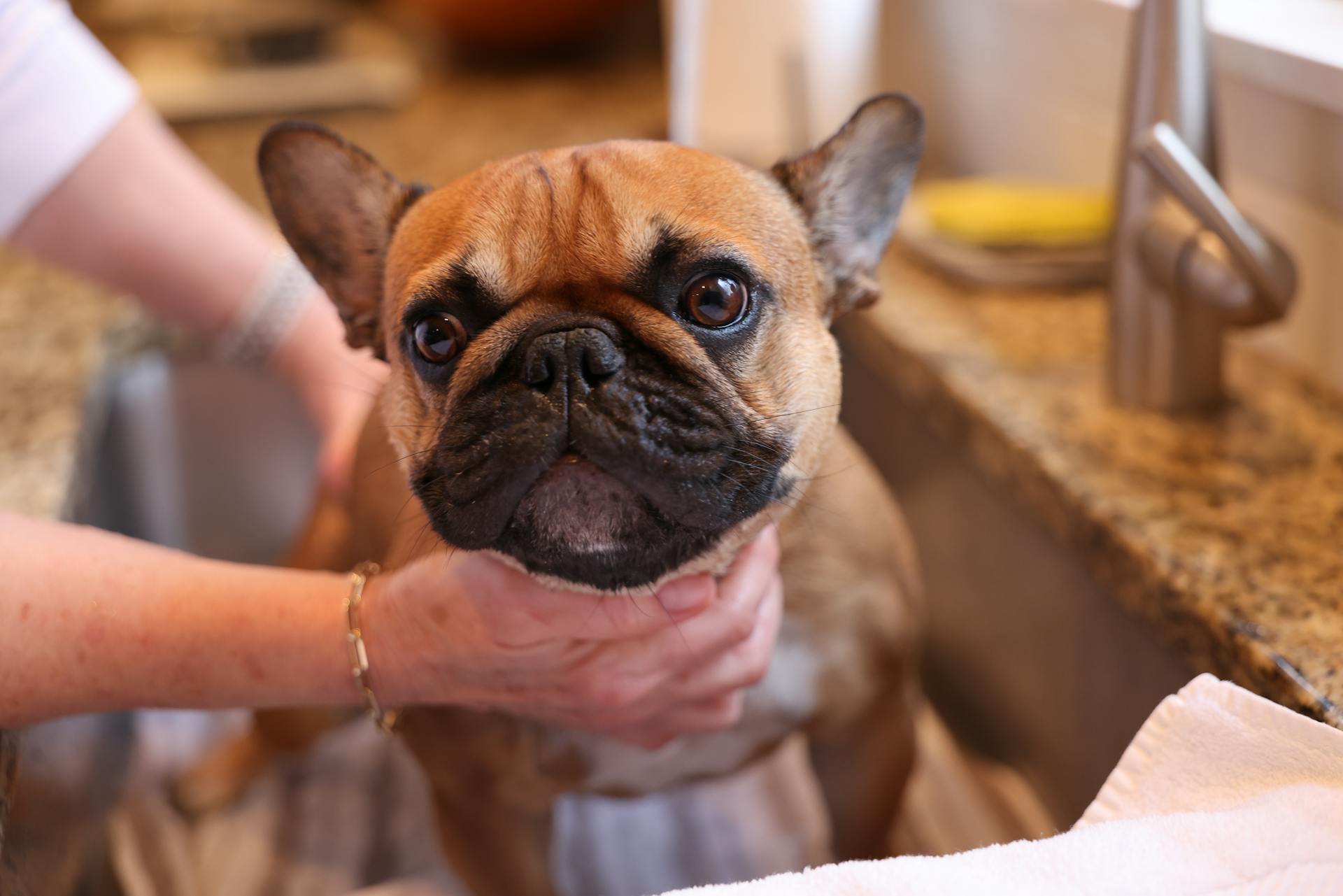
Surgical correction is a viable option for severe cases of breathing difficulties in French Bulldogs. Surgery can improve airflow by widening narrowed nostrils or reducing an elongated soft palate.
A veterinarian will thoroughly examine your dog to determine if surgery is necessary. This includes an examination of the mouth and respiratory tract, and possibly X-rays or other imaging tests.
Surgery is usually recommended for dogs showing signs of severe respiratory distress. Recovery and improvement vary per individual, and a vet should evaluate the potential benefits versus risks.
Here's a general outline of what you can expect:
- Preparation of the patient, including general anesthesia
- Removal of excess soft palate tissue
- Stitching the wound
- Waking up from anesthesia and observation
Recovery time varies from dog to dog, but typically most dogs need about two to four weeks to fully recover from surgery. It's essential to keep your dog quiet for at least 10 days after surgery to prevent complications.
Surgery FAQs
Surgery is usually an outpatient procedure, but some surgeries require an overnight hospital stay.
Most surgeons use general anesthesia to keep patients comfortable and pain-free during surgery.
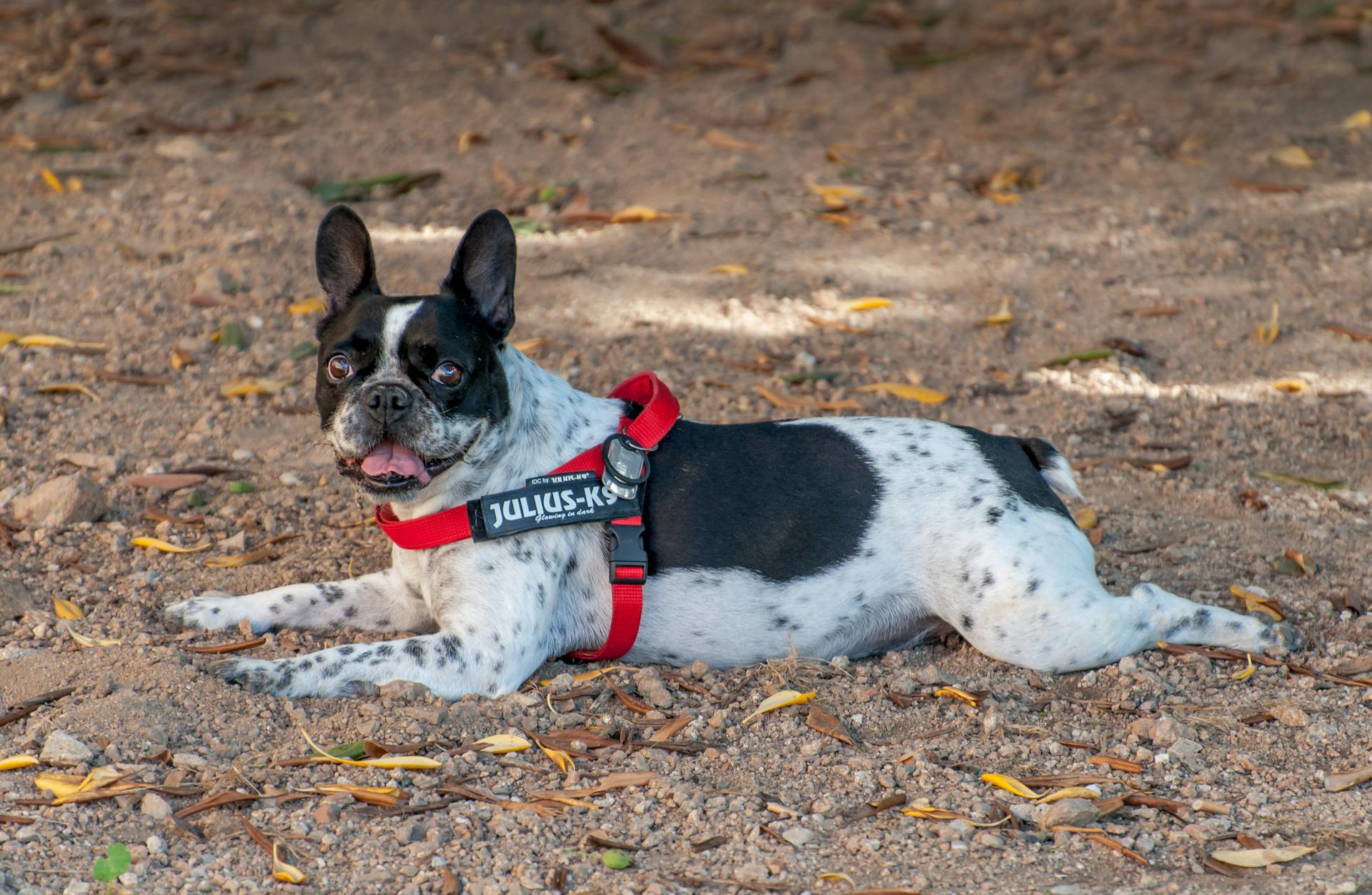
The length of recovery time varies greatly depending on the type of surgery and individual factors.
On average, it takes 2-6 weeks to recover from a laparoscopic surgery.
Some surgeries, like cataract removal, have a very short recovery time, often just a few hours.
Surgical complications are rare, but they can happen in up to 5% of cases.
A skilled surgeon can minimize the risk of complications and ensure a smooth recovery.
It's essential to follow post-operative instructions carefully to avoid any potential complications.
The cost of surgery can vary widely depending on the type of procedure, location, and insurance coverage.
Most insurance plans cover a significant portion of surgical costs, but out-of-pocket expenses can still be substantial.
It's essential to discuss costs and insurance coverage with your surgeon and insurance provider before undergoing surgery.
You might enjoy: Types of Bulldog Breeds
Lifestyle Changes and Management
As you make lifestyle changes to help your French Bulldog breathe better, it's essential to avoid high temperatures outside, which can cause them more trouble breathing and lead to heat stroke. Keep your dog in a cool, air-conditioned environment to reduce the risk of overheating.
High humidity and extreme heat should also be avoided, and ensure your pet has a comfortable space to rest away from stressful stimuli that may trigger heavy breathing. Heavy fragrances should be kept away from your dog.
Cigarette smoking should be avoided, as it can harm your dog's health. Use a harness to put less pressure on your dog's throat rather than a collar when you take them for walks. This can help reduce the strain on their breathing.
Stick to short exercise sessions, such as a 10 to 15-minute walk each day. Be aware of your dog's symptoms, and if you notice they're having trouble keeping up or seem fatigued, pick them up and carry them home.
Frequently Asked Questions
How do you decongest a French Bulldog?
To help decongest a French Bulldog, use a saline nasal spray and steam inhalation by running a hot shower for 15 minutes daily. If symptoms persist or worsen, consult a vet for further guidance.
Sources
- https://topfrenchie.com/french-bulldog-health-care/french-bulldog-breathing-problems/
- https://www.petplace.com/article/dogs/breeds/dog-breeds/french-bulldog-breathing-problems-things-to-know
- https://www.dogster.com/ask-the-vet/bulldog-breathing-problems
- https://pudgybulls.com/how-to-fix-french-bulldog-breathing-problems/
- https://tierarzt-karlsruhe-durlach.de/en/successful-french-bulldog-soft-palate-op/
Featured Images: pexels.com

